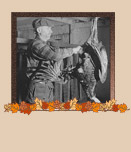| 
Images are visual documents that record history. A picture captures
a moment in time, but can be worth a thousand words to the viewer.
Every image meant something to the person who created it. Learning
how to unlock the meaning of images can provide students with a
broader understanding of events, objects, and people. The American
Memory collections are filled with fascinating photos and prints
that have stories to tell about holidays and traditions. Begin by
having students analyze this photograph of Mr.
Metzendorf. Study the visual details using the three-step process
– observe, think, and ask. Use these guiding questions or
create your own. Students can use a graphic
organizer to record their observations.
• Observe: Have students carefully study the image.
What people or objects can be seen? How are they arranged? Describe
the man. How is he dressed? What is the man doing to the turkey?
What is the expression on his face? Describe the turkey. What is
the physical setting? What other details can be seen? Use descriptive
terms so that someone who has not seen the image might visualize
it.
• Think: Read the caption for clues. When was this photo
taken? Where was it taken? What did Mr. Metzendorf do for a living?
Use these clues to draw upon students' prior knowledge. What do
they already know about the economics of the time in which the picture
was taken? What do they know about poultry farming? What is really
happening in the photo? Why do they think the photographer took
the photo? Was the photo posed or candid? What might have happened
a minute before this photograph was taken? What might happen a minute
after? Does anything in this image relate to the students' personal
experience?
• Ask: After studying the image, reading the caption,
making careful observations, and drawing on prior knowledge, what
questions remain? What would students like to know to help them
better understand the photograph. Is poultry farming the same today?
What ethical issues do turkey farmers face? What resources can help
them find out about the 1940s? Where can they learn more about the
poultry industry? Are there related photographs in the American
Memory collections? What other primary source documents might help
them place this photo into historical context?
Visual analysis becomes easier with practice. Using images can make
history come alive for students. Model this process by analyzing
one image with the entire class. Then divide students into pairs
or small groups to practice this technique on their own. Construct
and use a Primary
Source Toolkit to add authenticity to this activity. Follow
the links on the left for a sampling of holiday-related photographs
and images from the American Memory collections. Search
for more images using specific holiday names, seasons (fall, autumn),
animals (turkey), activities (dining, hiking, harvest), or related
terms.
|

